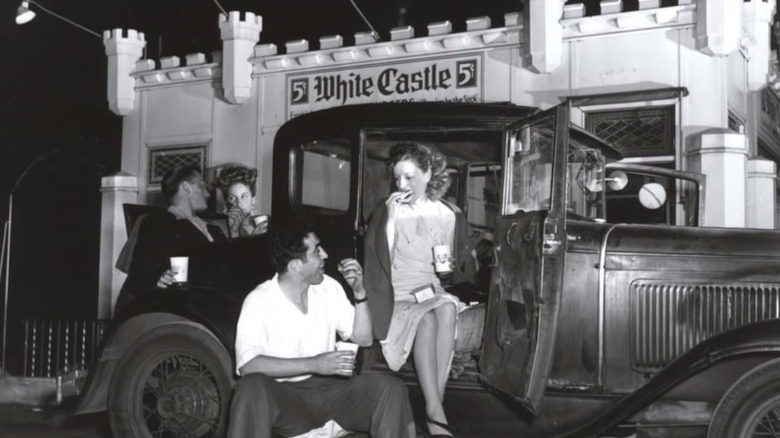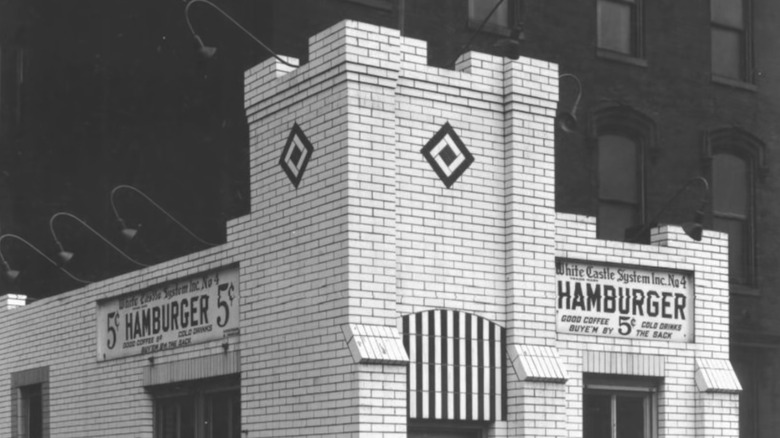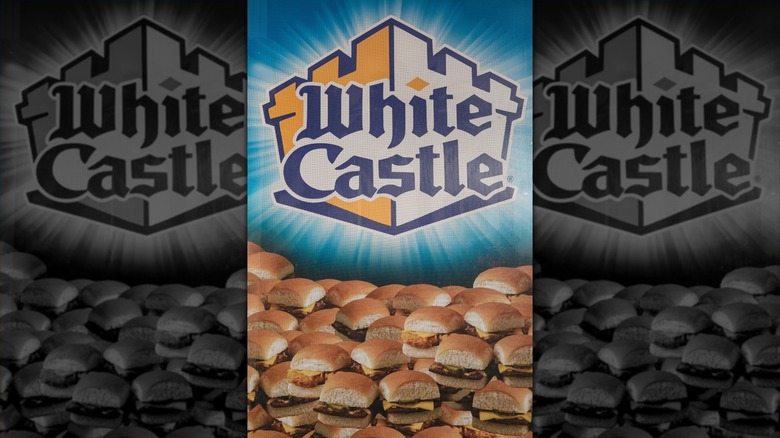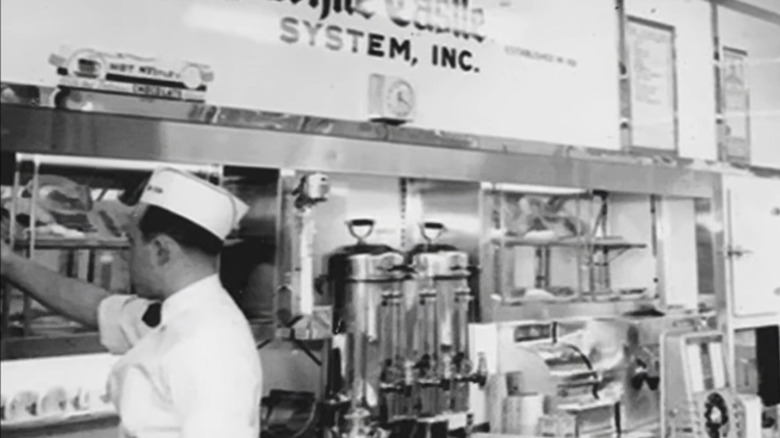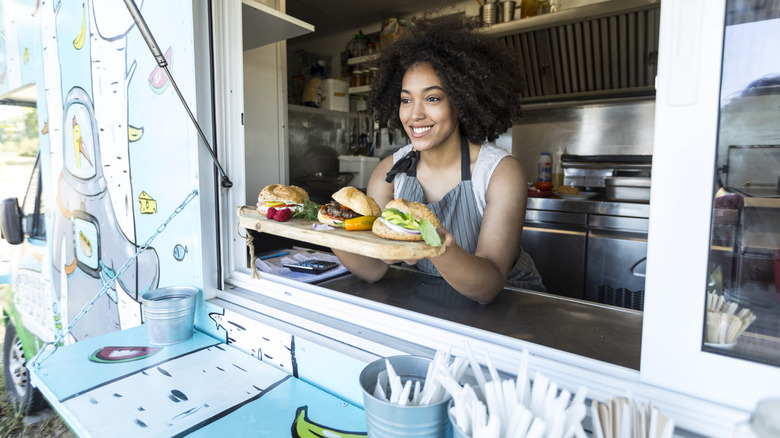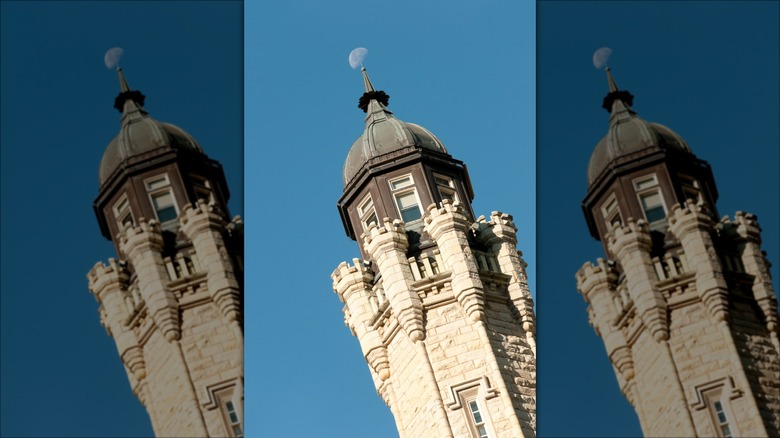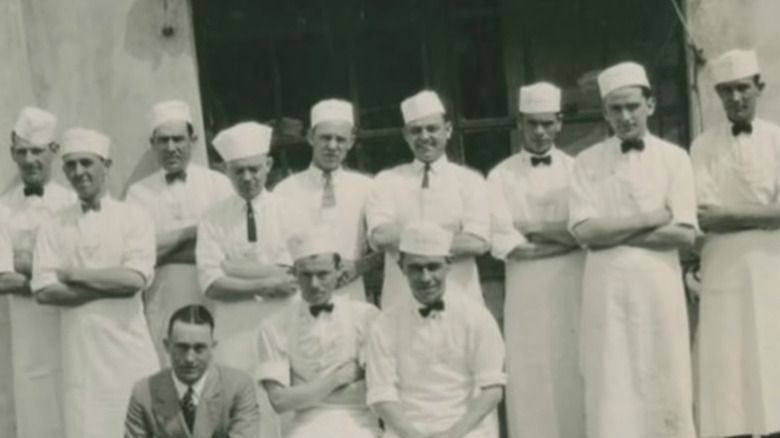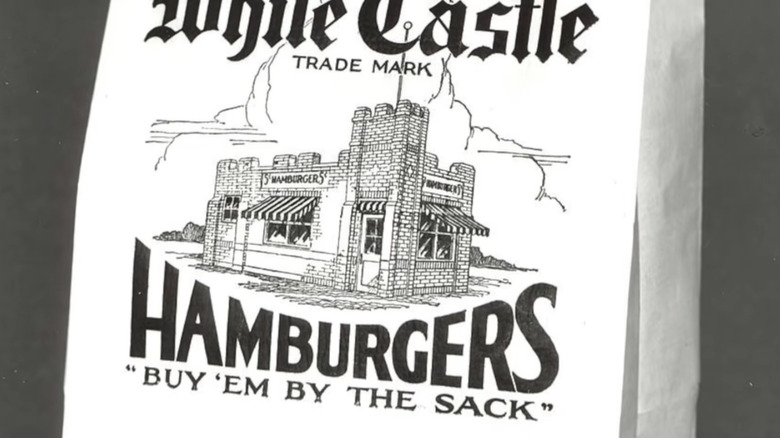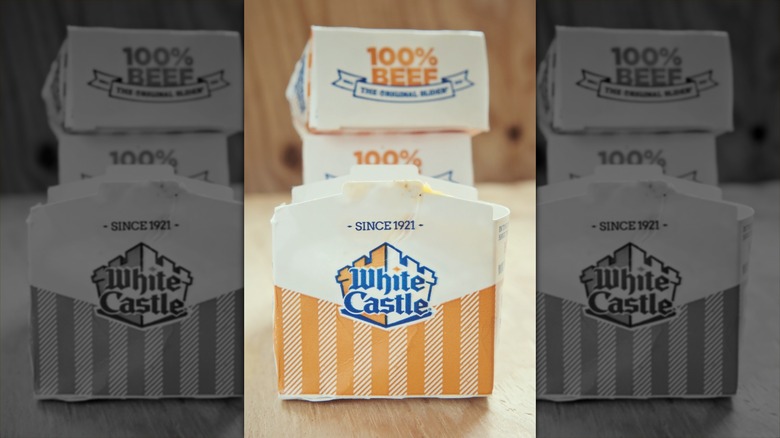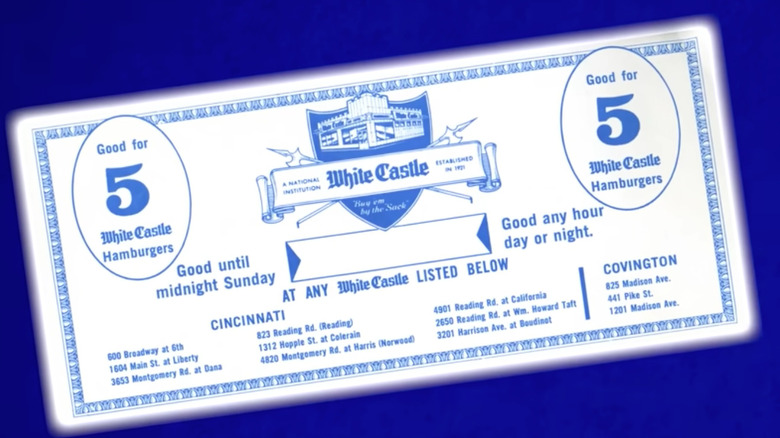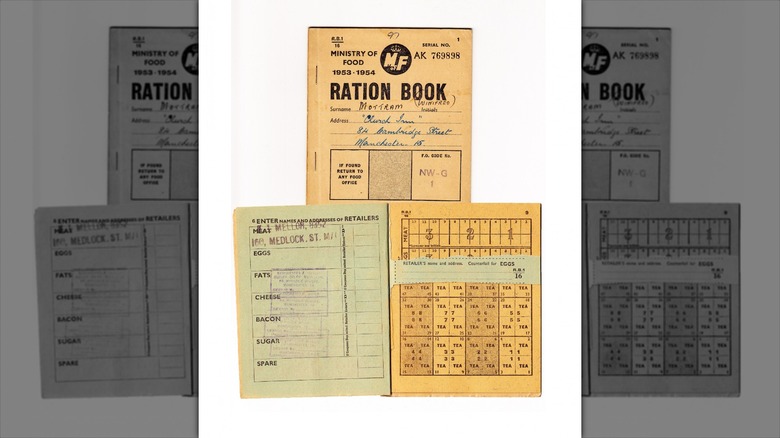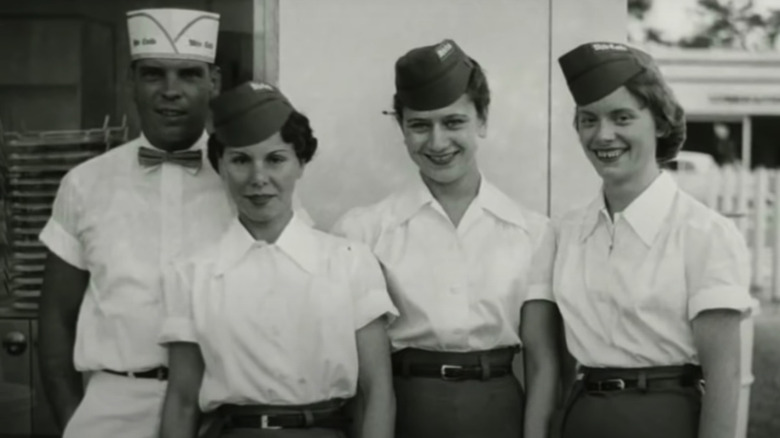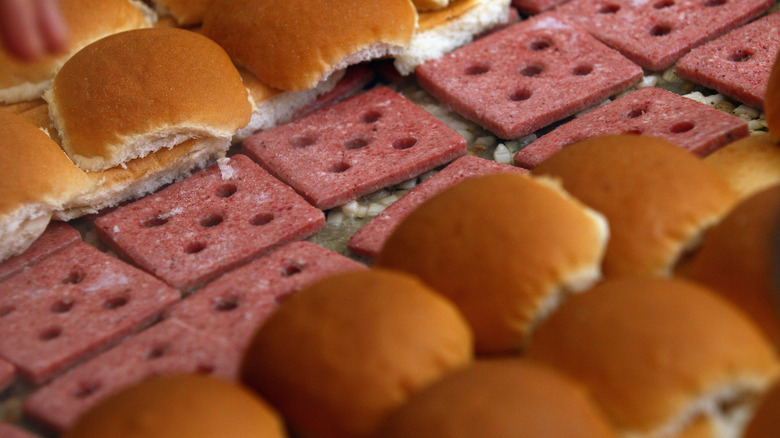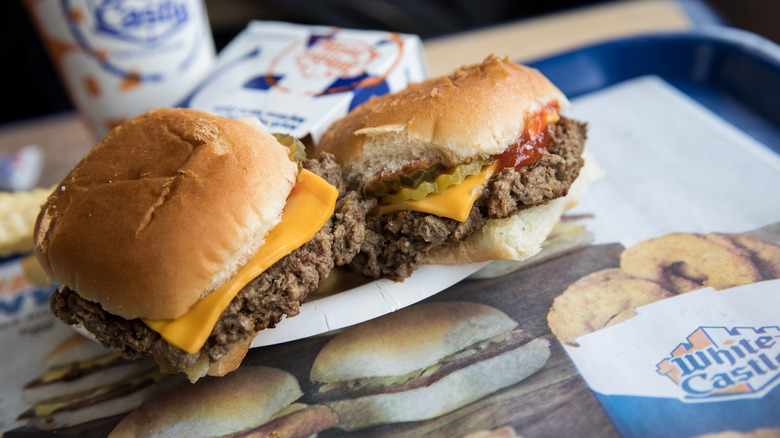What It Was Like Eating At The First White Castle
In the early part of the 20th century, food safety left a lot to be desired, a fact that author Upton Sinclair chronicled in his book "The Jungle." His tale captured the truth about the meat packing industry, an industry where rats roamed the floor freely and diseased animal carcasses made their way from packing house to packaged food, in a manner of speaking. It's no exaggeration to say that his story drove people away from eating meat for years to come.
Enter White Castle, the little hamburger restaurant that could. Despite people having a decided distaste for eating meat due to Sinclair's novel, White Castle co-founders Billy Ingram and Walter Anderson set up their restaurant in 1921 and began selling hamburgers by the sack. By 1930, the pair had sold enough burgers to have 116 stores in 12 cities. Much of their success had to do with being the antithesis of the meat industry as usual. It also didn't hurt that Billy Ingram was pretty much a marketing genius.
In short, when White Castle began in the early part of the 20th century, it was like nothing that anyone had ever seen. For early restaurant customers, White Castle ushered in a new era of delicious convenience they couldn't get enough of. From its castle facade to its clean interiors and cute little slider burgers, early customers loved buying burgers by the sack at White Castle.
The cost of the original store was $700
Who could imagine a castle that costs only $700? While it might seem like the stuff of legends, the original Palace de Hamburgers that's known as White Castle today cost only $700 in 1921 when it was first built. According to the Inflation Calculator, that's equivalent to just over $12,000 today. By comparison, it costs around $100,000 to start a food truck business in the 21st century, per Cloud Kitchens. And for those with bigger ambitions, buying a restaurant will set you back at least $175 Grand and up to $700K, according to Toast. In other words, the $700 burger castle in America's Heartland was a royal deal!
Residents of Witchita, Kansas, were the first to visit the palatial grounds of that $700 American castle. While the trappings of that first burger palace were modest, to say the least, its influence on the burger industry left a tall shadow that stretched forward in time for decades. As for the cost of a White Castle restaurant today, that's a bit harder to nail down simply because owning a White Castle franchise is impossible. The company doesn't offer franchises.
White Castle introduced hamburger sandwiches to the public
Hamburgers play such a big role in American food culture. You see their influence everywhere, from the tasty burger featured in the movie "Pulp Fiction" to burgers being the basis on which the state of the world economy is measured. We're speaking here, of course, about the Big Mac Index. The Big Mac Index, which is based on maybe the most famous American-born burger, the Big Mac, keeps track of how well people around the world keep up with inflation and such by looking at the price of a Big Mac in each person's country.
We bring all of this up to highlight just how much American hamburgers have infiltrated our consciousness and our culture. However, until White Castle co-founder Walter Anderson, took it upon himself to squish a meatball flat and shove it between two pieces of bread, Americans didn't really eat burgers. Early visitors to White Castle had none of the cultural references to hamburgers that we do today. For them, eating a burger was a questionable experience at best. While the first White Castle burgers may not have equaled the wonder that first-time visitors to Disney World experience, it was a new eating adventure for folks in the 1920s.
And you don't have to take our word for it that it was a novel experience. In 2014, TIME magazine named the White Castle slider the "most influential burger of all time." You don't get an honor like that without bringing something new and significant to the proverbial table.
Having a sanitary appearance was of the utmost importance
Because of Upton Sinclair's novel "The Jungle," the year 1921 was not exactly the most ideal environment in which to drop a fledgling burger stand. For some restauranteurs, this might have presented too much of an obstacle. For White Castle's Walter Anderson, this presented an opportunity instead. If he could demonstrate that his hamburger stand adhered to the strictest cleanliness requirements, he could then tap into a public that felt the time to try some tasty burgers had come.
To prove how sanitary his new burger establishment was, Anderson adopted a couple of smart practices. First, he kept the place clean. Second, his setup allowed him to cook customers' burgers right in front of them. He put the kibosh on any worry about poisoning by rotting meat by putting practices into place that made the restaurant-going public feel at ease.
Finally, in 1930, Billy Ingram, in partnership with the University of Minnesota, commissioned a study which followed a college student who ate nothing but White Castle sandwiches and good, high-quality H2O for 13 weeks. At the end of the study, the hamburger-noshing student got a declaration of good health. All of these steps combined helped to eventually change the perception of burgers as filthy food and ushered in an era where a plate of burgers on a Saturday afternoon meant a perfectly wholesome meal.
The first White Castle restaurant was a burger stand in Kansas
The white turreted facade of White Castle has become so synonymous with its image that it's difficult to imagine it looking any other way. But the restaurant chain's very first restaurant entered the world as just a burger stand. Walter Anderson had developed something of a reputation for being a creative cook. He built burgers with piles of onions, an assortment of condiments, and a ton of "Ooohs" and "Aaahs" from the patrons he served as a grill cook.
He took the foundation he got from his restaurant work, talked someone into giving him 80 smackeroos and invested in a shoe-shine stand. This he subsequently converted into a burger stand. The addition of three stools in the front allowed his first guests to sit a spell and watch him cook their burgers while they waited. At that time, the burger stand didn't even have the moniker nor its castle-like silhouette that would eventually make him and his soon-to-be partner, Billy Ingram, famous. It was just a burger stand in Kansas that produced some great burgers that made a series of regular customers who came back time and again for seconds.
Chicago's water tower inspired the restaurants' design... Sort of...
The White Castle founders' desire to serve a burger that ranked a step above the public's expectations of food started with first impressions. The reputation of the meat industry during the early part of the 20th century was sullied, to put it kindly. The public face of the meat industry needed a facelift. The success of Ingram's and Anderson's fledgling business venture depended on such a transformation. Enter the Chicago Water Tower. This edifice holds the distinction of being one of the few buildings that survived the Chicago fire of 1871 which destroyed over 17,000 buildings and caused $200 million in damage, per Britannica.
Its turreted brick design signified strength and permanence, something that Ingram and Anderson wanted their White Castle restaurants to also represent to the public. The addition of similarly textured pristine white bricks to the White Castle restaurants' design not only brought with them a solidity reminiscent of the water tower itself but also evoked cleanliness, a character trait that early White Castle patrons must have appreciated.
The earliest White Castles employed only men
Image played a big role in the selection of employees at White Castle in the early days. Inspired by a desire to look and be sanitary at all times, Anderson and his new partner, Billy Ingram, hired young men, who they called "operators," to man the restaurants. They wore crisp, stain-free white uniforms, including pressed white aprons. A black tie highlighted friendly faces. Two of them worked each shift.
What's more, Ingram and Anderson ensured that the men working for them always looked clean and pressed because the company, not the employees, cleaned the uniforms that the early White Castle crews wore. The pristine look of their employees, along with their attitudes of polite helpfulness, were among the reasons that White Castle was able to eventually change the image the public had of burgers. The popular restaurant staple went from something potentially spoiled and produced by ill-gotten means to be an item that represented wholesomeness and good taste. The young men who worked for the company represented a visual embodiment of this.
White Castle customers enjoyed $.05 hamburgers by the sack
A lack of sit-down space required the powers that be at early White Castle restaurants to adopt some creative measures to sell their burgers. If it wasn't exactly convenient for customers to come in and sit with their families to eat at White Castle for dinner, then White Castle would make carrying dinner out an attractive option. From this idea arose $.05 hamburgers housed in insulated boxes, which White Castle sold by the sack, with five to a sack.
Given that the sliders were as small then as they are today, the average family of five probably couldn't fill up on the sack of burgers, though in all fairness, it was the size of White Castle's famous sliders that allowed the burger to prosper. It could be cooked and bagged up fast, ready to be taken home and eaten.
Further, the price of the burgers made them an economical meal, even if it meant that a family might have to buy two sacks to have enough for dinner. In fact, the price of White Castle, in general, allowed the restaurant chain to thrive, even during the Great Depression of the 1930s. In just a decade's time, the burger went from a practical pariah in the 1920s to a powerful food staple in the 1930s as everyone from mega movie stars to Joe Schmoe adopted them as a food of choice.
The company protected customers by switching to insulated branded boxes
Fast food produces juices and an abundance of grease, which, if one isn't careful, trickles down the chin and onto the shirt. This was just as true in the 1920s when White Castle began as it is today. Although the founders of White Castle couldn't prevent people from dribbling their food on their chins, they could do something about the hamburger grease dribbling on their clothes. White Castle customers likely felt pleasant surprise when they opened their bag'o'burgers to find those burgers encased in boxes.
Certainly, the boxes probably looked great, being decorated with White Castle's special marketing imagery and all, but the real magic of the White Castle branded boxes came from the special coating inside them. It prevented the grease from sliding out of the box, down the front of the sack, and onto someone's clothes as they drove home with their bags of burgers. The boxes also had the added benefit of keeping the food warm, allowing them to enjoy a hot dinner once they arrived home. An employee by the name of Maurice "Benny" Benfer hatched the idea of spraying the boxes with a protective shield of sorts at some point during the 1930s. We're not saying that he got a promotion because of that, but it probably didn't hurt his career, either, given that he eventually became the VP of Public and Human Communications of White Castle.
Customers saved money by using White Castle coupons
White Castle's early success rested on its constant innovations, which, when looked at through today's lens, seem a bit elementary, but they were anything but elementary at the time of their inceptions. Case in point? Look through your Sunday newspaper insert. It's likely that you'll see coupons for McDonald's, Burger King, and Wendy's. Newspaper burger coupons are a dime a dozen nowadays, but back in 1933, when White Castle put the first coupon in the newspaper for five burgers for a dime, burger coupons weren't a dime a dozen. They were none a dozen. Newspaper coupons for hamburgers arose from White Castle's ingenuity.
This, no doubt, pleased customers who would have been feeling the grip of the Great Depression by then. Customers could redeem the coupon, provided that they came in after 2:00 p.m. and provided that they opted for carryout. If the crash of '29 eventually caused the run on banks in the '30s, it might be said that White Castle's newspaper coupons caused a run on burgers in '33. A lot of customers who came in way after 2:00 p.m. probably felt some disappointment on coupon day as, one by one, each White Castle ran out of food for the day.
The company ceased restaurant expansion during WWII
World War II changed people's eating habits in so many ways, thanks to food rationing. As the war tapped more and more resources, like food supplies, gas, and rubber, the American public had to learn to do with less and less. Each month, everyone in the country got ration books filled with coupons, which they could redeem at the local grocery store. Local grocers helped them keep track of how many rations they used. Once a customer bought something, like meat, the grocer took the customer's ration card. Once rations ran out for the month, that was it until the next month rolled around.
Rationing didn't just affect the common folk, however. Restaurants felt it, too. While they did get about 30% more ration cards than the average Joe, few events, other than maybe the invention of TV, changed food history quite as much. Because of wartime rations, expanding into new territory was out of the question for the restaurant chain. To survive the war years, White Castle served fried egg sandwiches and baked beans. And its subsidiary, Porcelain Steel Buildings Co., which was created as a way to mass produce White Castle restaurant buildings, made amphibious vehicles for the war effort instead.
During WWII, women provided the bulk of the restaurant help
World War II didn't just prompt the rationing of food. It also prompted the rationing of male workers, causing many employers who didn't employ women to reconsider their stances. This included White Castle, which, until the war broke out, only hired young men ages 18 to 24. However, White Castle owner Billy Ingram, who was the person who originally decided to hire only young men, was prompted to change his mind. He had to because, in 1941, the chain lost about half its staff to the war's cause.
Ingram wasn't crazy about the idea of having a female staff, so initially, he lowered his standards in terms of the quality of young men he hired. But eventually, the reckoning came. If he wanted to keep the castle's light on and the mote filled, then he needed to reconsider his position on hiring women. As it turns out, hiring women made the stores more profitable than they had ever been in the male-employees-only days.
Square burgers with holes in them were introduced in the early 1950s
Unlike the round burgers that fast-food fans could get at diners and places like McDonald's in the 1950s, White Castle broke with that industry norm and served square hamburgers with holes punched in them. We should point out that, in the beginning, even White Castle had round beef patties.
However, in 1954, an employee named Earl Howell had an idea. He thought that if the company produced burgers with holes in them, grill workers at the restaurants could steam the beef patties on a bed of onions. The onion steam not only flavored the meat but also gave the buns, which cooks placed on top of the cooking patties, an onion flavor.
More importantly to the customers of White Castle at the time, this practice allowed cooks to cook 18 patties at a time without having to flip them. No flipping equaled faster cooking times, which, in turn, meant less time to wait for dinner. With that, the era of the round burger at White Castle ended, and the era of the square burger began.
The little burgers easily slid down the throat, giving them their name
When hunger strikes, it's human nature to want food that slides down the throat easily and effortlessly. It doesn't hurt if the food – let's call it a mini hamburger – also happens to be delish, so delish, in fact, that happy foodies would be inspired to eat a bagful of such a recipe. It was this desire for such a meal that inspired White Castle to call its burgers sliders. The White Castle slider, though simple in concept, proved to be a game-changer in the food industry. When the restaurant first opened in the 1920s, founder Billy Ingram crafted his unusual burgers by rolling out a round meatball and then smashing it with a spatula until it was the round, flat patty that most burger lovers know and adore. Early White Castle burgers then got a sprinkle of onions and a pickle before being dropped into a branded box for carryout or served to customers at the counter.
Those early sliders didn't just slide down the throat. They slid into people's hearts, allowing White Castle to sell 21 million burgers by the 1930s, according to Whiting-Robertsdale Historical Society. Many other restaurants have sold sliders since then, but it's only thanks to the ingenuity of Billy Ingram and the customers who loved his early sliders that we even have such a concept today.
